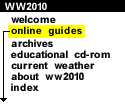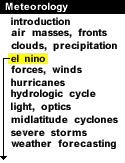
|
There are several means used for El Niño detection; satellites, moored ATLAS and PROTEUS buoys, drifting buoys, sea level analysis, and XBT's. Since El Niño influences global weather patterns and affects human lives and ecosystems, prediction of an El Niño event is becoming increasingly important. For short term prediction (up to 1 year) of climate variations, current observations in the Tropical Pacific are vital. Numerical models are used in many places for El Niño prediction and research. Here are some of the latest El Niño forecasts.
Given that numerical models predicting El Niño must do so months in advance, they are not as reliable as those used in predicting the weather, which forecast only days in advance. They have, however, progressed to the point where they can reproduce the characteristics of a typical El Niño event and some industries use these forecasts as an indicator of the coming fish harvest.
Forecasts are presented in terms of possible
conditions for South America:
(1) near normal conditions,
(2) a weak El Niño with a slightly wetter than normal
growing season,
(3) a full blown El Niño with flooding,
(4) cooler than normal waters offshore,
with higher than normal chance of drought in South America.
Once the forecast is issued, management of agriculture, water supplies, fisheries, and other resources can be modified.

economic impacts |
|

Forces, Winds |



